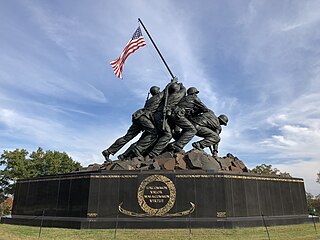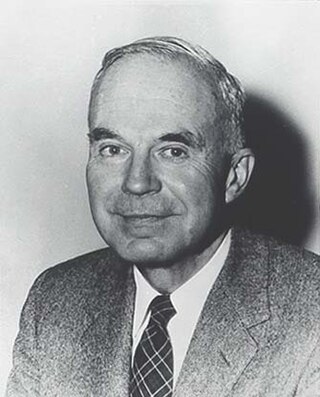
The United States Marine Corps War Memorial is a national memorial located in Arlington County, Virginia. The memorial was dedicated in 1954 to all Marines who have given their lives in defense of the United States since 1775. It is located in Arlington Ridge Park within the George Washington Memorial Parkway, near the Ord-Weitzel Gate to Arlington National Cemetery and the Netherlands Carillon. The memorial was turned over to the National Park Service in 1955.

The Statue of Freedom, also known as Armed Freedom or simply Freedom, is a bronze statue designed by Thomas Crawford that, since 1863, has crowned the United States Capitol dome. Originally named Freedom Triumphant in War and Peace, a U.S. government publication now states that the statue "is officially known as the Statue of Freedom." The statue depicts a female figure bearing a military helmet and holding a sheathed sword in her right hand and a laurel wreath and shield in her left.

The United States Bicentennial was a series of celebrations and observances during the mid-1970s that paid tribute to historical events leading up to the creation of the United States of America as an independent republic. It was a central event in the memory of the American Revolution. The Bicentennial culminated on Sunday, July 4, 1976, with the 200th anniversary of the adoption of the Declaration of Independence by the Founding Fathers in the Second Continental Congress.

The Jefferson Memorial is a presidential memorial built in Washington, D.C., between 1939 and 1943 in honor of Thomas Jefferson, the principal author of the United States Declaration of Independence, a central intellectual force behind the American Revolution, founder of the Democratic-Republican Party, and the nation's third president.

William Ordway Partridge was an American sculptor, teacher and author. Among his best-known works are the Shakespeare Monument in Chicago, the equestrian statue of General Grant in Brooklyn, the Pietà at St. Patrick's Cathedral in Manhattan, and the Pocahontas statue in Jamestown, Virginia.

The Lincoln Tomb is the final resting place of Abraham Lincoln, the 16th president of the United States; his wife Mary Todd Lincoln; and three of their four sons: Edward, William, and Thomas. It is located in Oak Ridge Cemetery in Springfield, Illinois.

Iron Mike is the de facto name of various monuments commemorating servicemen of the United States military. The term "Iron Mike" is uniquely American slang used to refer to men who are especially tough, brave, and inspiring; it was originally a nautical term for a gyrocompass, used to keep a ship on an unwavering course. Because the use of the slang term was popular in the first half of the 20th century, many statues from that period acquired the Iron Mike nickname, and over the generations the artists' titles were largely forgotten. Even official military publications and classroom texts tend to prefer the nickname to the original titles.

Pompeo Luigi Coppini was an Italian born sculptor who emigrated to the United States. Although his works can be found in Italy, Mexico and a number of U.S. states, the majority of his work can be found in Texas. He is particularly famous for the Alamo Plaza work, Spirit of Sacrifice, a.k.a. The Alamo Cenotaph, as well as numerous statues honoring Texan figures, such as Lawrence Sullivan Ross, the fourth President of Texas A&M University.

Walker Kirtland Hancock was an American sculptor and teacher. He created notable monumental sculptures, including the Pennsylvania Railroad World War II Memorial (1950–52) at 30th Street Station in Philadelphia, and the World War I Soldiers' Memorial (1936–38) in St. Louis, Missouri. He made major additions to the National Cathedral in Washington, D.C., including Christ in Majesty (1972), the bas relief over the High Altar. Works by him are presently housed at the U.S. Military Academy at West Point, the Library of Congress, the U.S. Supreme Court, and the United States Capitol.

Ernest Moore Viquesney was an American sculptor best known for his popular World War I monument Spirit of the American Doughboy.
Sir Brett-Livingstone Strong is an Australian-born artist, best known for his historic monumental sculptures and portraits of Hollywood celebrities.

Major General Marquis Gilbert de Lafayette is a statue in the southeast corner of Lafayette Square, in Washington, D.C., near the junction of Pennsylvania Avenue with Madison Place and close to the White House. The statue was erected in 1891 to honor Gilbert du Motier, Marquis de Lafayette and his contribution in the American Revolutionary War. The square, originally part of the President's Park, was named in honor of the Marquis in 1824. The statuary was made by Alexandre Falguière and Antonin Mercié, and the architect who designed the marble pedestal was Paul Pujol..

The Virginia Monument, also commonly referred to as "The State of Virginia Monument", is a Battle of Gettysburg memorial to the commonwealth's "Sons at Gettysburg" with a bronze statue of Robert E. Lee on his horse Traveller and a "bronze group of figures representing the Artillery, Infantry, and Cavalry of the Confederate Army". The equestrian statue is atop a granite pedestal and the group of six standing figures is on a sculpted bronze base with the figures facing the Field of Pickett's Charge and the equestrian statue of Union General George G. Meade on Cemetery Ridge. The granite pedestal without either sculpture was dedicated on June 30, 1913 for the 1913 Gettysburg reunion. On June 8, 1917, Virginia governor Henry C. Stuart presented the completed memorial to the public.

Lincoln Monument (Philadelphia) is a monument honoring Abraham Lincoln in Fairmount Park, Philadelphia, Pennsylvania, United States. One of the first initiated in memory of the assassinated president, the monument was designed by neoclassical sculptor Randolph Rogers and completed in 1871. It is now located northeast of the intersection of Kelly Drive and Sedgley Drive, opposite Boathouse Row.

The Jefferson Monument is a statue by Moses Jacob Ezekiel located outside the Louisville Metro Hall in Louisville, Kentucky, US.

The U.S. Military Working Dog Teams National Monument is a monument to military working dogs located at Joint Base San Antonio (JBSA)-Lackland in San Antonio, Texas. The monument represents handlers, dogs, and veterinary support, from all military service branches that have made up the Military Working Dog program since World War II. The monument grounds include a 3,000 square feet granite plaza, granite pedestals, granite history wall, granite benches and water fountain. The granite pedestals have large bronze statues of dogs and handlers. The monument was dedicated on October 28, 2013.
The Augusta-Central Savannah River Area (CSRA) Vietnam War Veterans Memorial is a granite and bronze monument placed in Augusta, Georgia, March 29, 2019, to honor the CSRA's 169 Vietnam War dead, three Ex-Prisoners of War (Vietnam), and one former Missing in Action (MIA) as well as the region's 15,000 surviving Vietnam War Veterans. The memorial is located in the "Olde Town" section of Augusta, Georgia, on the Broad Street median between Third and Fourth Streets. The monument was designed, purchased, and placed by the Augusta Chapter of the Military Order of the World Wars (MOWW) and the chapter's 17 community partners who made up the Augusta-CSRA Vietnam War Memorial Initiative (VWMI) Steering Committee.

The Stonewall Jackson Monument in Richmond, Virginia, was erected in honor of Thomas Jonathon "Stonewall" Jackson, a Confederate general. The monument was located at the centre of the crossing of Monument Avenue and North Arthur Ashe Boulevard, in Richmond, Virginia. The bronze equestrian statue was unveiled in 1919. Along this avenue are other statues including Robert E. Lee, J. E. B. Stewart, Jefferson Davis, Matthew Maury and more recently Arthur Ashe. Thomas Jackson is best known as one of Robert E. Lee's most trusted commanders throughout the early period of the American Civil War between Southern Confederate states and Northern Union states. He rose to prominence after his vital role in the Confederate victory at the First Battle of Bull Run in July 1861, continuing to command troops until his untimely death on May 10, 1863, after falling fatally ill following the amputation of his wounded arm.

A statue of Frederick Douglass sculpted by Sidney W. Edwards, sometimes called the Frederick Douglass Monument, was installed in Rochester, New York in 1899 after it was commissioned by the African-American activist John W. Thompson. According to Visualising Slavery: Art Across the African Diaspora, it was the first statue in the United States that memorialized a specific African-American person.

Stevens T. Mason, also known as the Stevens T. Mason Monument, is a monumental statue in Detroit, Michigan, United States. The monument was designed by sculptor Albert Weinert and architect H. Van Buren Magonigle in honor of Stevens T. Mason, who had served as the first governor of Michigan in the mid-1800s and is notable for being the youngest person to ever serve as the governor of a U.S. state. Mason's remains are interred underneath the monument, which is located in Capitol Park, the site of the former state capitol building. The monument was dedicated on Memorial Day 1908.


















